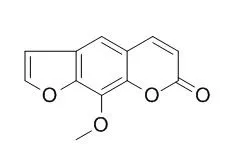| Description: |
Xanthotoxin (Methoxsalen ) is a potent tricyclic furocoumarin suicide inhibitor of CYP (cytochrome P-450), is an agent used to treat psoriasis, eczema, vitiligo and some cutaneous Lymphomas in conjunction with exposing the skin to sunlight. Xanthotoxin has anticonvulsant activities, it can protect the animals against maximal electroshock-induced seizures; Xanthotoxin prevents bone loss in ovariectomized mice through the inhibition of RANKL-induced osteoclastogenesis, it may be considered to be a new therapeutic candidate for treating osteoporosis. |
| In vitro: |
| Osteoporos Int. 2016 Jul;27(7):2335-2344. | | Xanthotoxin prevents bone loss in ovariectomized mice through the inhibition of RANKL-induced osteoclastogenesis.[Pubmed: 26809192] | Xanthotoxin (XAT) is extracted from the seeds of Ammi majus. Here, we reported that XAT has an inhibitory effect on osteoclastogenesis in vitro through the suppression of both receptor activator of nuclear factor-κB ligand (RANKL)-induced ROS generation and Ca(2+) oscillations. In vivo studies showed that XAT treatment decreases the osteoclast number, prevents bone loss, and restores bone strength in ovariectomized mice.
Excessive osteoclast formation and the resultant increase in bone resorption activity are key pathogenic factors of osteoporosis. In the present study, we have investigated the effects of XAT, a natural furanocoumarin, on the RANKL-mediated osteoclastogenesis in vitro and on ovariectomy-mediated bone loss in vivo.
METHODS AND RESULTS:
Cytotoxicity of XAT was evaluated using bone marrow macrophages (BMMs). Osteoclast differentiation, formation, and fusion were assessed using the tartrate-resistant acid phosphatase (TRAP) stain, the actin cytoskeleton and focal adhesion (FAK) stain, and the fusion assay, respectively. Osteoclastic bone resorption was evaluated using the pit formation assay. Reactive oxygen species (ROS) generation and removal were evaluated using dichlorodihydrofluorescein diacetate (DCFH-DA). Ca(2+) oscillations and their downstream signaling targets were then detected. The ovariectomized (OVX) mouse model was adopted for our in vivo studies.
In vitro assays revealed that XAT inhibited the differentiation, formation, fusion, and bone resorption activity of osteoclasts. The inhibitory effect of XAT on osteoclastogenesis was associated with decreased intracellular ROS generation. XAT treatment also suppressed RANKL-induced Ca(2+) oscillations and the activation of the resultant downstream calcium-CaMKK/PYK2 signaling. Through these two mechanisms, XAT downregulated the key osteoclastogenic factors nuclear factor of activated T cells c1 (NFATc1) and c-FOS. Our in vivo studies showed that XAT treatment decreases the osteoclast number, prevents bone loss, rescues bone microarchitecture, and restores bone strength in OVX mice.
CONCLUSIONS:
Our findings indicate that XAT is protective against ovariectomy-mediated bone loss through the inhibition of RANKL-mediated osteoclastogenesis. Therefore, XAT may be considered to be a new therapeutic candidate for treating osteoporosis. |
|
| In vivo: |
| Neuropharmacology. 2014 Oct;85:67-72. | | Effects of methoxsalen, a CYP2A5/6 inhibitor, on nicotine dependence behaviors in mice.[Pubmed: 24859605] | Metabolism of nicotine to inactive cotinine by hepatic enzyme CYP2A6 is the principal pathway by which active nicotine is removed from circulation.
METHODS AND RESULTS:
We therefore hypothesized that inhibition of mouse CYP2A5, the ortolog of human CYP2A6, by methoxsalen (8-methoxypsoralen) alter dependence-related behaviors of nicotine in the mouse. Conditioned place preference (CPP) test was used to assess the appetitive reward-like properties and precipitated nicotine withdrawal to assess physical (somatic and hyperalgesia) and affective (anxiety-related behaviors) measures. The nicotine plasma levels were also measured with or without methoxsalen pretreatment. Methoxsalen (15 and 30 mg/kg, intraperitoneally) pretreatment enhanced nicotine-induced preference in mice (p<0.05). However, there was a lack of enhancement of nicotine in the CPP test after the highest dose of the CYP-2A5 inhibitor. Similarly to the CPP results, repeated administration of methoxsalen increased the intensity of mecamylamine-precipitated withdrawal signs. The potentiation of nicotine preference and withdrawal intensity by methoxsalen was accompanied by significant increase in nicotine plasma levels in mice (p<0.05). Finally, methoxsalen enhanced the ability of a very low dose of nicotine (0.05 mg/kg) to reverse withdrawal signs in mice undergoing spontaneous withdrawal after chronic nicotine infusion (p<0.05).
CONCLUSIONS:
In conclusion, inhibition of nicotine metabolism by methoxsalen alters the behavioral effects of nicotine in the mouse. Combining CYP2A6 inhibitors with low dose nicotine replacement therapies may have a beneficial role in smoking cessation because it will decrease the drug elimination rate and maintain plasma and brain nicotine levels. | | Pharmacol Rep. 2010 Nov-Dec;62(6):1231-6. | | Anticonvulsant effects of four linear furanocoumarins, bergapten, imperatorin, oxypeucedanin, and xanthotoxin, in the mouse maximal electroshock-induced seizure model: a comparative study.[Pubmed: 21273683] | The aim of this study was to determine and compare the anticonvulsant activities of four natural furanocoumarins [bergapten (5-methoxypsoralen), imperatorin (8-isopentenyloxypsoralen), oxypeucedanin (5-epoxy-isopentenyloxypsoralen) and Xanthotoxin (8-methoxypsoralen)] in the maximal electroshock-induced seizure test in mice.
METHODS AND RESULTS:
The anticonvulsant effects of bergapten, imperatorin, oxypeucedanin, and Xanthotoxin were evaluated at 15, 30, 60 and 120 min after their systemic (intraperitoneal) administration. Tonic hind limb extension (seizure activity) was evoked in adult albino Swiss mice by a current (sine-wave, 25 mA, 500 V, 50 Hz, 0.2 s stimulus duration) delivered via auricular electrodes. The time courses of protection by bergapten, imperatorin, oxypeucedanin and Xanthotoxin against maximal electroshock-induced seizures revealed that 300 mg/kg imperatorin and Xanthotoxin (C-8 substituted derivatives of psoralen) exerted strong anticonvulsant activity, whereas 300 mg/kg bergapten and oxypeucedanin (C-5 substituted derivatives of psoralen) did not produce any anticonvulsant activity in this model.
CONCLUSIONS:
In conclusion, imperatorin and Xanthotoxin protected the animals against maximal electroshock-induced seizures, whereas bergapten and oxypeucedanin, despite their chemical and structural similarities to Xanthotoxin and imperatorin, exerted no anticonvulsant activity in this seizure test. |
|






 Cell. 2018 Jan 11;172(1-2):249-261.e12. doi: 10.1016/j.cell.2017.12.019.IF=36.216(2019)
Cell. 2018 Jan 11;172(1-2):249-261.e12. doi: 10.1016/j.cell.2017.12.019.IF=36.216(2019) Cell Metab. 2020 Mar 3;31(3):534-548.e5. doi: 10.1016/j.cmet.2020.01.002.IF=22.415(2019)
Cell Metab. 2020 Mar 3;31(3):534-548.e5. doi: 10.1016/j.cmet.2020.01.002.IF=22.415(2019) Mol Cell. 2017 Nov 16;68(4):673-685.e6. doi: 10.1016/j.molcel.2017.10.022.IF=14.548(2019)
Mol Cell. 2017 Nov 16;68(4):673-685.e6. doi: 10.1016/j.molcel.2017.10.022.IF=14.548(2019)